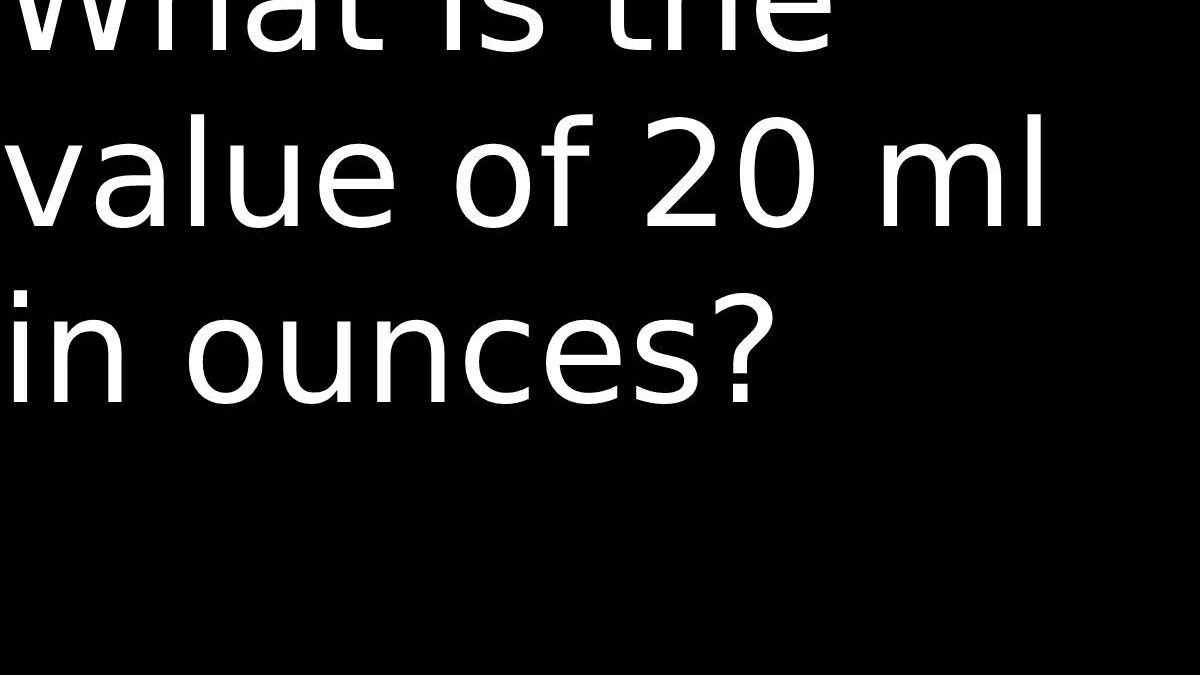20 ml in ounces?
20 mL is equal to 0.6763 oz, or there are 0.6763 ounces in 20 ml.
Table of Contents
What Is The Value Of 20 Ml In Ounces?
20 ml equals 0.6763 ounces, or there are 0.6763 ounces in 20 millilitres.
| 20 MILLILITERS CONVERSION |
| US fluid ounces 0.6763 |
| Millimetres 0.02 |
| liquid gallons 0.0052840158520476 |
| cups 0.084388185654008 |
| Liquid Quartz 0.040322580645161 |
| US liquid pints 0.042283298097252 |
| Legal Cups 0.083333333333333 |
| tablespoons 1.3525393927098 |
| US teaspoon 4.0576181781294 |
| British gallons 0.0043994720633524 |
| Kaiser quart 0.017590149516271 |
| Imperial pints 0.035211267605634 |
| cups 0.070422535211268 |
| Imperial fluid ounces 0.70390314292753 |
| Tablespoons 1.126252956414 |
| Teaspoons 3.3789491468153 |
The 20ml Oz Calculator converts 20 milliliters to ounces and vice versa exactly. It converts 20ml into cups, litres, pints and more at once.
20 milliliters equals 0.67628 ounces
To convert any milliliter value to ounces, simply multiply the milliliter value by the conversion factor 0.033814022701843. So 20 milliliters times 0.033814022701843 equals 0.67628 ounces.
20 milliliters = 0.67628 ounces
Formula: Multiply the value in ml by the conversion factor “0.0338140227018”.
So 20 ml= 20 × 0.0338140227018 = 0.676280454036 ounces.
Approximate values for 20 ml in ounces
2/3 ounce (1.4% more)
3/4 ounce (11% more)
3/5 ounce (11% more)
5/8 ounce (7.6% more)
11/16 ounces (1.7% more)
These are alternate values for 20 milliliters in ounces. They are represented as a fraction or whole number close to the exact value (Etc.). The approximation error, if any, is to the right of the value.
To calculate a milliliter value to the equivalent ounce value, simply multiply the milliliter amount by 0.033814022701843 (the conversion factor). Here is the formula:
Value in ounces = Value in milliliters × 0.033814022701843
Suppose you want to convert 20 milliliters to ounces. Using the conversion formula above, you get:
Value in ounces = 20 × 0.033814022701843 = 0.67628 ounces
| Millilitres to ounces conversion chart | |||||||||||||||||||||||||||||||
|
|
||||||||||||||||||||||||||||||
Faqs On Conversions
20 Ml Of Water Equals How Many Ounces?
20 ml of water is equivalent 0.705 ( ~ 3/4) ounce.
0.705 ounce of water in ml?
0.705 ounce of water matches 20 milliliters.
Where Do Ounces Originate?
The use of the ounce began in way back to Scotland and England to quantity wine, liquid and beer, but the size of the ounce has tended to vary depending on the liquid measurement system, giving rise to a number of different ‘named’ ounces including; the rook, the troy ounce and the avoirdupois.
The old system was even more flawed, using “allocations” meaning that “a unit of measure is not essentially equal to the sum of its parts”, due to an old custom of taking estimated weight into account. the packaging or the packaging material.
To put an end to the misperception, the British Parliament decided in 1824 that the “imperial gallon” was equal to the volume of ten quid of water. The imperial gallon can be shared into four equal parts or pints, which can be divided into two pints, the halves into four gills, and the gills into five ounces
160 imperial fluid ounces make one imperial gallon, making one imperial fluid ounce of water equal to about 28.4 g, and later, after the introduction of liters, 28.4 ml.
However, the US government decided to stick with the old measure, which was based on the old gallon of wine used in England before the 1824 changes, which contained approximately 231 cubic inches; This unit of measurement is now known as the “American gallon”. Because of this slight difference, the US fluid ounce is approximately 4% larger than the imperial fluid ounce, measuring approximately 29.5 mL instead of the imperial 28.4 mL; However, as use of the imperial ounce has declined around the world, the US gallon is often the unit of measurement in question.
So Why Liters, Centiliters And Milliliters?
If you read a recipe outside of the United States, you probably won’t find anything that isn’t in the “metric” or “modern” system, but milliliters and liters exist much longer than the imperial system, which is often used as that “old” form of measurement.
The liter was first derived in France in 1795 and introduced as the new “republican unit of measurement”, equal to one cubic decimeter. A liter corresponds to the volume of a cube with a side length of 10 cm, and the mass is almost exactly one kilogram.
While the official system in the United States is the US Customary Units, based primarily on the imperial system, most things are listed with both measurements in most other parts of the world due to the use of the metric system; speed, fluids, body weight and length.
What is the easiest way to change Ounces to millilitres.
You never know when you strength need to change OZ to ML or vice versa, but it’s a close trick to have up your sleeve (especially if you spend a lot of time outside the US).
Once you know the conversion, you can make an educated guess about the conversion even if you don’t have a calculator or Google handy.
0.033814022589 ounces go into one milliliter, where one ounce equals 29.57 milliliters. The easiest way to change ounces to milliliters is to round the 29.57ml ounce to the nearest 30ml and multiply by the number of ounces in existence. This will give you a rough idea of how many milliliters is that many ounces. Working the other way can be a lot more difficult, instead of multiplying the ounces by ml you have to divide them.


